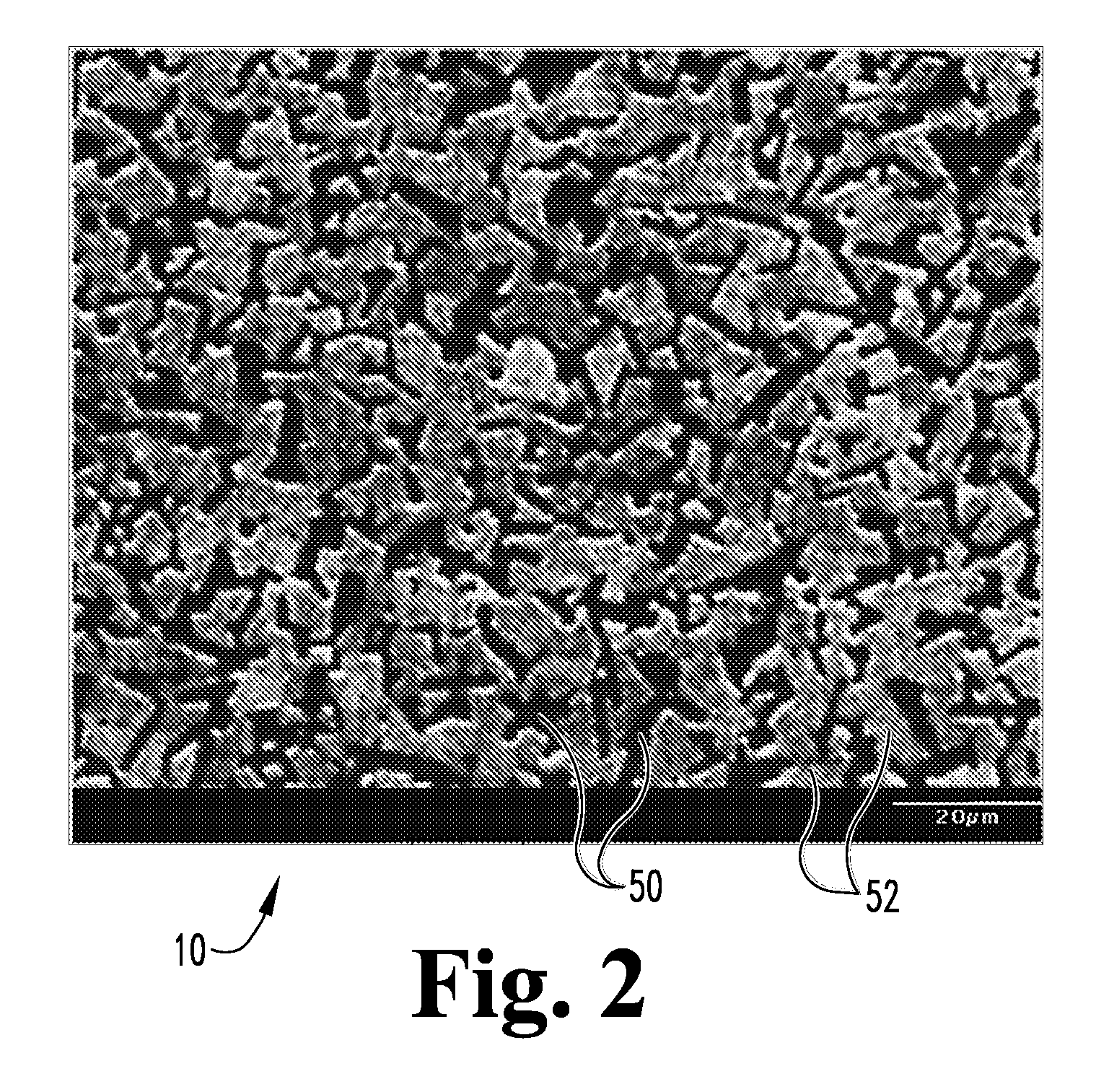Pressurelessly sintered zirconium diboride/silicon carbide composite bodies and a method for producing the same
- Summary
- Abstract
- Description
- Claims
- Application Information
AI Technical Summary
Benefits of technology
Problems solved by technology
Method used
Image
Examples
example 1
[0030]A ZrB2—SiC composite composition may be formed as having 20 weight percent SiC, 3 weight percent carbon derived from phenolic resin (which also acts as a binder), and the remainder ZrB2. The composition may be dispersed in a MEK liquid medium and ball milled for 24 hours with WC media so as to be thoroughly mixed. The mixed slurry may be dried to yield a mixed powder, and the recovered powder may be ground and sieved to a predetermined desired particle size distribution. A portion of the sieved powder may then be formed into a green body via uniaxial pressing followed by cold isostatic pressing. The green body may then be heated to about 600 degrees Celsius in flowing argon and held at that temperature for 4 hours to volatilize and evolve gasses produced through resin decomposition. The green body may then be heated to 1650 degrees Celsius in a partial vacuum and held there for up to 6 hours to volatilize boron oxides and react any other oxide impurities with the reducing agen...
example 2
[0031]A ZrB2—SiC composite precursor composition may be formed as having 15 weight percent SiC, 2 weight percent carbon black, 2 weight percent organic binder, 3 weight percent B4C, and the remainder ZrB2. The starting composition may be dispersed in a MEK liquid medium and ball milled for 24 hours with WC media so as to be thoroughly mixed. The slurry of the mixed powders may be dried to yield a mixed powder with binder, and the recovered powder may be ground and sieved to a predetermined desired granule size distribution. A portion of the sieved granules may then be formed into a green body via cold isostatic pressing. The green body may then be heated to about 400 degrees Celsius in flowing argon and held at that temperature for 4 hours to decompose and volatilize the binder. The green body may then be heated to 1650 degrees Celsius in a partial vacuum and held there for 4 hours to remove volatile boron oxides and to react the remaining oxide impurities with the carbon and B4C; s...
example 3
[0032]A ZrB2—SiC composite composition may be formed as having 10 weight percent SiC, 3 weight percent carbon, 2 weight percent organic binder, and the remainder ZrB2. The initial composition may be dispersed in a MEK liquid medium and ball milled for 24 hours with WC media so as to be thoroughly mixed. The slurry of the mixed powders may be dried to yield a mixed powder with binder, and the recovered powder may be ground and sieved to a predetermined desired granule size distribution. A portion of the sieved granules may then be formed into a green body via cold isostatic pressing. The green body may then be heated to about 350 degrees Celsius in flowing argon and held at that temperature for 4 hours to decompose and volatilize the binder. The green body may then be heated to 1650 degrees Celsius in a partial vacuum and held there for 6 hours to volatilize any boron oxides and to react any other oxide impurities with the reducing agent additive; such impurities are reduced by the a...
PUM
| Property | Measurement | Unit |
|---|---|---|
| Temperature | aaaaa | aaaaa |
| Temperature | aaaaa | aaaaa |
| Temperature | aaaaa | aaaaa |
Abstract
Description
Claims
Application Information
 Login to View More
Login to View More - R&D
- Intellectual Property
- Life Sciences
- Materials
- Tech Scout
- Unparalleled Data Quality
- Higher Quality Content
- 60% Fewer Hallucinations
Browse by: Latest US Patents, China's latest patents, Technical Efficacy Thesaurus, Application Domain, Technology Topic, Popular Technical Reports.
© 2025 PatSnap. All rights reserved.Legal|Privacy policy|Modern Slavery Act Transparency Statement|Sitemap|About US| Contact US: help@patsnap.com


